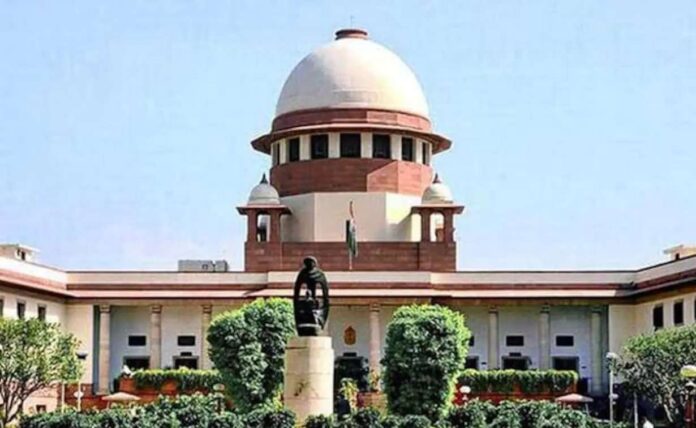The issue of forced conversions from one religious denomination to another has been brought into fresh focus when the Supreme Court recently observed that such conversions were “dangerous” and that they were “seriously against the interest of the nation”. A two-judge Bench of Justices M.R. Shah and Hima Kohli said: “Everybody has a right to choose religion but not by force or by giving some temptation.” The court was responding to a public interest litigation filed by advocate Ashwini Upadhyay, who had asked for strong measures to check religious conversions through coercion and fraud. The judges also noted that, while there was freedom of religion in the country, there was no freedom to forcefully convert.
By Rajesh Singh
The contentious matter is not a new one. The subject of conversions forced or otherwise, has received the attention of several leading public figures for long. Back in 1893, while delivering his famous address at the World Parliament of Religions, Swami Vivekananda had said, “The Christian is not to become Hindu or a Buddhist, nor is the Hindu or Buddhist to become a Christian. But each must integrate the spirit of others and yet preserve his individuality and grow according to his own law of growth.”
Mahatma Gandhi too often expressed his displeasure over religious conversions. He once remarked, “If I had power and could legislate, the first thing I would ban is conversions.”
The Buddhist spiritual leader, Dalai Lama, has also made clear his opposition to religious conversions. On one occasion, in the backdrop of news reports that he had blessed an event of mass conversion from Hinduism to Buddhism, his office stated, “His Holiness the Dalai Lama is always against conversion of a people, community or an individual from one religion to another.”
The lawyer, Ashwini Upadhyay, had earlier this year tried to convince the Delhi High Court on the need for a law to contain forced conversions, but the court had taken the stand that the petitioner had not provided enough material to substantiate his claim of coercive conversion. While he claimed that mass conversions through the use of intimidation and deceit, especially among the the socially and economically weaker sections of the society, was rampant, the court said, “There is nothing, no documentation, not one instance given by you… Where are the statistics? How many conversions happened? Who is converted? You say mass conversion is happening, where is the number?” The High Court dismissed media and social media reports that Upadhyay offered of forced conversions, saying that such material could not be considered tenable. The judges were unconvinced by Upadhyay’s argument that religious conversion by “the carrot and the stick” and “by hook or crook” not only offended Articles 14, 15, 21, and 25 of the Constitution but also went against the principles of secularism, enshrined in the Preamble to the Constitution.
The PIL by Upadhyay was apparently meant to prod the current Union government into bringing a central legislation to check forced conversions. Back in 1954, an attempt was made by the government of the day to tackle the issue. The Indian Conversion (Regulation and Registration) Bill was introduced in Parliament, and it sought licensing mechanisms and registration of conversions. But the Bill fell by the wayside for want of numbers in the Lok Sabha. Then the Backward Communities (Religious Protection) Bill was introduced in 1960 with the stated aim of “checking conversion Hindus to non-Indian religions”, and thereafter Freedom of Religion Bill in 1970 came with a goal to have ‘official curbs on inter-religious conversion.” However, both these initiatives failed, again for lack of numbers in Parliament.
The reluctance of Union governments in more recent years to have a central legislation is largely premised on the argument that a pan-India law could not be created since police and public order is a state subject under the Seventh Schedule of the Constitution (Article 246). As recently as in 2015, the Union Ministry of Law & Justice had opined that a national-level anti-conversion legislation could not be enacted since law and order was a state subject; the States were, therefore, free to have their own laws to tackle religious conversions.
Over the years, thus, several States have enacted legislations of one kind or the other in that direction. Among them are Madhya Pradesh, Odisha, Arunachal Pradesh, Chhattisgarh, Gujarat, Himachal Pradesh, Jharkhand and Uttarakhand. While a few other States have promised similar laws, some of the existing laws have been amended to make them more stringent; others have promised changes to make their respective legislations more effective.
It would be pertinent here to note that perhaps that most comprehensive documentation of questionable religious conversions was provided by the Report of the Christian Missionary Activities Enquiry Committee of 1956, otherwise known as the Niyogi Committee Report, appointed by the Madhya Pradesh government vide a resolution dated 14 April, 1954. Headed by Bhawani Shankar Niyogi, a former chairman of the State’s Public Service Commission and retired Chief Justice of the High Court of Judicature at Nagpur, the panel comprised several prominent figures as its members.
The introduction of the report mentioned the reason for the inquiry: “It was represented to Government from time to time that the conversion of illiterate aboriginals and other backward people was effected by the Christian missionaries either forcibly or through fraud or temptations of monetary gain, and the Government were informed that the feelings of non-Christians were being offended by conversions brought about by such methods.” The missionaries expectedly vehemently denied the allegation and claimed instead that they were being harassed by the local government authorities and non-Christians. “This committee was, therefore, appointed… to have a thorough enquiry made into the whole question.”
In that same introduction, the committee said that, initially, full cooperation was extended to the panel by the authorities and members of the Roman Catholic Church; however, later on, that cooperative attitude ceased to exist. The report said, “But subsequently the Catholic Church withdrew its cooperation, not only filing a statement of protest, but also moving the High Court for a mandamus Petition…” The petition was dismissed with the court stating that it was within the competence of the State government to establish a fact-finding committee and that no fundamental rights of citizens had been infringed upon.
The exhaustive nature of the Niyogi Committee was evident in the fact that the panel toured as many as fourteen districts of the State, more than 13,000 people were contacted for details, 77 centers were visited (with the panel members making notes at each centre), and 375 statements were recorded in writing. The members visited nearly 700 villages and studied the functioning of mission-run schools, hospitals and other institutions to gain a holistic understanding. While there was unanimity on the excellent service the missionaries were rendering in the areas of health and education, there was also disquiet over the use of these facilities to secure converts.
Following a comprehensive survey and study of the situation on the ground, the committee arrived at many conclusions, some of which were as follows:-
- There had been an enormous increase in the personnel associated with missionary (conversion) work in the State, drawing from the constitutional provisions regarding religious freedom.
- Conversions mostly happened by undue influence, misrepresentation etc — thus, not through conviction but by inducements.
- A vile propaganda had been systematically and deliberately unleashed against the majority religion (Hinduism).
- Schools, orphanages and hospitals were being used to facilitate proselytisation.
The Niyogi panel also offered a slew of recommendations to the State government on the basis of its findings, among them being:-
- Missionaries who had arrived with the main objective to proselytise should be asked to pack their bags and quit the country.
- Indian churches should stop being dependent on foreign funds.
- Use of professional services such as health and education as a means to convert should be barred by law.
- The right of propagation of religion should not be taken as a right to convert.
- Circulation of literature of religious propaganda should be done only with the approval of State authorities.
A great deal of water has flowed under the bridge since 1954, and often the boot is now on the other foot. Take the example of Kerala, where Christian bodies have raised their voice against conversion of Christians to Islam. Some months ago, a video went viral on many Christian WhatsApp groups in the State, and was shared by the Christian Association and alliance for Social Action, ‘exposing Love Jihad’. The caption of the video, in Malayalam, read: “The Left (CPI (M)-led Left Democratic Front) and the Right (Congress-led United Democratic Front) are competing to appease jihadists by covertly and overtly justifying the form of terrorism known as love jihad. We should not allow the jihadists to grow in their (LDF’s and UDF’s) shadow. For that, we need to cut down the trees that provide them shelter. Think… Act.”
In another example, the influential Syro-Malabar Church in Kerala issued a statement expressing concern over targeting of Christian women through ‘Love Jihad’. The Bishop of Pala, a town in the State, went to the extent of warning Christians against socialising with Muslims, alleging the frequent use of ‘Love Jihad’. Incidentally, the term ‘Love Jihad’ also originated from Kerala, and one of the judges of the Kerala High Court had directed the State’s Director General Police to conduct investigations into such cases.
Essentially, the terminology refers to the luring of non-Muslim women by Muslim men into wedlock through fraud. But others claim that there is no such thing as “Love Jihad’ and that it is a fanciful construct by certain sections of society and politicians reflecting their Islamophobia.
Whether there is ‘Love Jihad’ or not, forced conversions certainly are, and they need to be tackled. Neither the central nor the State governments can turn a blind eye to the phenomenon.
This article first appeared in www.vifindia.org and it belongs to them.








